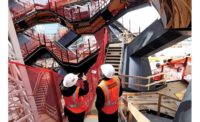You might call 2018 “the year of the design firm” for ENR’s New York-New Jersey region, with many engineering and architecture companies reporting strong revenue growth in key construction market sectors, according to the latest Top Design Firms ranking. Total 2018 revenue for the top 85 firms on the list was $4.92 billion, down slightly from the prior year, but revenue rose 19% for the 10 largest companies. Their $2.51 billion regional total was up from $2.11 billion.
In this year’s new array of top firms with varied market strengths, the results might seem uneven. Gensler dropped three spots to No. 8, even though its regional revenue grew 2.2% to $175.05 million from $171.27 million.
Revenue for the largest 10 firms in the education sector fell 3% to $148.11 million from $152.73 million, although executives from H2M Architects + Engineers, Clark Patterson Lee/CPL and Urbahn Architects—ENR New York’s Design Firm of the Year (see p. NY27)—say the sector remains a great opportunity.
“Public school districts are continuing to proceed with large bond issues to rehabilitate aging school buildings and school grounds,” says Dennis M. Kelleher, executive vice president at H2M, which rose to No. 22 from No. 25. The firm reported regional revenue of $72.7 million for the most recent year compared with $67.2 million in the year-ago period.
“The K-12 market sector has provided some nice opportunity for ongoing design work,” says Todd Liebert, CEO of Clark Patterson Lee, which participated in the Top Design Firms ranking for the first time, with reported regional revenue of $38 million, landing it at No. 29. “Successful referendums have and will translate into improved facilities for students and teachers across New York state, from academics to athletics,” he says.
|
Related Link |
Ups and Downs
But the top 10 firms also reported lagging revenue momentum from sustainability projects. Revenue related to green dropped 9% to $385.27 million in 2018 compared with $423.51 million in 2017; revenue in the category of environmental and geotechnical engineering declined 1.7% to $638.13 million. But again, firms are optimistic that these are one-year blips in otherwise strengthening market sectors.
“The most prevalent and necessary trends we see in design and construction are the implementation of green infrastructure and a focus on sustainability and energy efficiency,” Kelleher says. “Sustainable design is about much more than just green building materials; long term impact needs to be considered, and we are finding more creative ways to accommodate these needs.”
Among key building sectors, revenue for the largest 10 firms in multi-unit residential work showed continued cooling, dropping almost 16% in 2018 to $138.29 million from $164.43 million in 2017.
“We have seen a quieting of the ultra high-end luxury market,” says Alan R. Poeppel, managing principal at Langan. It reported a year-to-year regional revenue rise of 2.7% to $146 million in that category, despite falling to No. 11 from No. 9 in the main ranking. “With a potential high-end market saturation on our hands, we have seen developers hesitant to embark on new projects without an answer on the absorption rates of the current supply,” he points out.
On the plus side of residential, Poeppel says affordable and rental housing will remain a busy subsector, with the South Bronx and other outer boroughs having “an endless appetite for market rate rentals.”
One bright spot is the commercial sector, which grew 1.2% to $294.7 million in revenue for the top 10 design firms. “Commercial developments in the outer boroughs [are] reacting to the live-work demand on the millennial generation,” Poeppel says. He added that two other sectors related to the new economy also offer opportunities for design firms: last-mile logistics and fulfillment centers.
Region on the Move
Much better news comes from the transportation sector, with the top 10 firms reporting a whopping 30% rise in total regional revenue for 2018—to $1.44 billion from $1.11 billion.
“This region’s transportation network serves as the foundation of economic vitality and quality of life, and is now in the process of modernization,” says Stephen Dilts, senior vice president and New York office leader for HNTB Corp. Emerging opportunities abound in the region with an increased focus on infrastructure resilience and major project management in dense urban environments, he says.
Dilts points to the success of three bridge megaprojects on which HNTB was a team member—the Mario M. Cuomo, Goethals and Kosciuszko spans—and notes that they each used design-build procurement project delivery.
“The … process creates partnerships between designers and builders that help foster creative and innovative solutions that deliver projects faster and more cost effectively,” Dilts says. Kelleher also touts design-build as a current and continuing trend: “Prior to last year, you hardly ever would see this type of delivery method in New York state municipal markets.”
Innovative technologies are more in demand to generate added services and more revenue, executives note. “The continued use of integrated technology like VR [virtual reality], AR [augmented reality], 3D and other ‘reality capture’ tools—not only in deliverables but in pursuits—should provide continued efficiencies in both cost and scheduling,” Clark Patterson Lee’s Liebert says.
Virtual 3D modeling was critical in one company project: the Sands-Constellation Center for Critical Care—a $263-million, 312,000-sq-ft addition to Rochester General Hospital’s campus. It will have 20 operating rooms, 26 post-anesthesia beds, 108 private acuity-adaptable patient rooms, a nursery with 14 private rooms for babies, and eight labor and delivery rooms, among other features.
“Data management will also be big for us this coming year,” Liebert adds. “The integration of project, corporate and digital asset information is an important part of our strategic plan.”
Both New York and New Jersey show potential for future growth. The top 10 design firms working in New York reported total revenue that rose 11.2% last year to $1.79 billion, while New Jersey’s 10 leaders posted a 27% revenue rise—to $867.5 million from $682 million.








